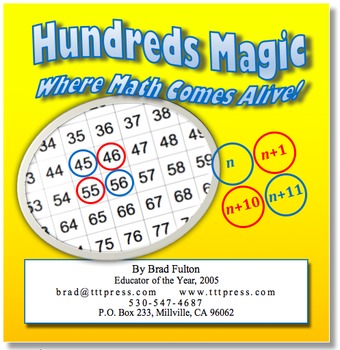Hundreds Magic: Where Math Comes Alive!
Teacher to Teacher Press
482 Followers
Grade Levels
5th - 9th, Homeschool
Subjects
Resource Type
Standards
CCSS5.NBT.B.5
CCSS5.OA.A.1
CCSS5.OA.A.2
CCSS5.OA.B.3
CCSS6.NS.C.5
Formats Included
- PDF
Pages
22 pages
Teacher to Teacher Press
482 Followers
Description
This is one of my students’ favorite activities. They love exploring the intriguing patterns and making discoveries, and they don’t even realize they are engaging in rigorous mathematics.
Students encounter the 100’s chart in the primary grades, but did you know that there is a wealth of arithmetic and algebra embedded in the chart for older students as well? You can use the 100’s chart to teach many math skills such as number operations, mental math, integers, functions, writing expressions, using variables, working with binomials, combining like terms, and even writing algebraic proofs.
Your students will love diving into this engaging activity and will find rich mathematics of their own. Just try to stop them!
Students encounter the 100’s chart in the primary grades, but did you know that there is a wealth of arithmetic and algebra embedded in the chart for older students as well? You can use the 100’s chart to teach many math skills such as number operations, mental math, integers, functions, writing expressions, using variables, working with binomials, combining like terms, and even writing algebraic proofs.
Your students will love diving into this engaging activity and will find rich mathematics of their own. Just try to stop them!
Total Pages
22 pages
Answer Key
Included
Teaching Duration
2 days
Report this resource to TPT
Reported resources will be reviewed by our team. Report this resource to let us know if this resource violates TPT’s content guidelines.
Standards
to see state-specific standards (only available in the US).
CCSS5.NBT.B.5
Fluently multiply multi-digit whole numbers using the standard algorithm.
CCSS5.OA.A.1
Use parentheses, brackets, or braces in numerical expressions, and evaluate expressions with these symbols.
CCSS5.OA.A.2
Write simple expressions that record calculations with numbers, and interpret numerical expressions without evaluating them. For example, express the calculation “add 8 and 7, then multiply by 2” as 2 × (8 + 7). Recognize that 3 × (18932 + 921) is three times as large as 18932 + 921, without having to calculate the indicated sum or product.
CCSS5.OA.B.3
Generate two numerical patterns using two given rules. Identify apparent relationships between corresponding terms. Form ordered pairs consisting of corresponding terms from the two patterns, and graph the ordered pairs on a coordinate plane. For example, given the rule “Add 3” and the starting number 0, and given the rule “Add 6” and the starting number 0, generate terms in the resulting sequences, and observe that the terms in one sequence are twice the corresponding terms in the other sequence. Explain informally why this is so.
CCSS6.NS.C.5
Understand that positive and negative numbers are used together to describe quantities having opposite directions or values (e.g., temperature above/below zero, elevation above/below sea level, credits/debits, positive/negative electric charge); use positive and negative numbers to represent quantities in real-world contexts, explaining the meaning of 0 in each situation.





